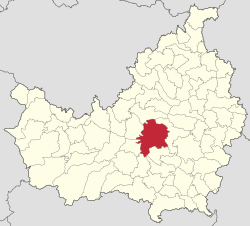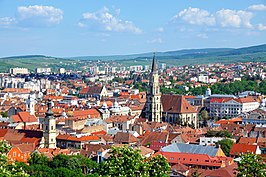
Back Cluj-Napoca ACE Cluj-Napoca AN Clūsenburg ANG كلوج نابوكا Arabic كلوج-ناپوكا ARY كلوج نابوكا ARZ Cluj-Napoca AST Kluj-Napoka Azerbaijani کلوژ-نپوکا AZB Клуж-Напока Bashkir
Cluj-Napoca | |
|---|---|
From top and left: Cluj-Napoca panorama • St. Michael's Church • Dormition of the Theotokos Cathedral • Medieval house of Matthias Corvinus • Romanian National Opera • Babeș-Bolyai University | |
| Nickname(s): | |
 Location in Cluj County | |
| Coordinates: 46°46′N 23°35′E / 46.767°N 23.583°E | |
| Country | Romania |
| County | Cluj County |
| Status | County seat |
| Founded | 1213 (first official record as Clus) |
| Government | |
| • Mayor (2020–2024) | Emil Boc[3] (PNL) |
| • Deputy Mayor | Dan Tarcea (PNL) |
| • Deputy Mayor | Emese Oláh (UDMR) |
| • City Manager | Gheorghe Șurubaru (PNL) |
| Area | |
| • City | 179.5 km2 (69.3 sq mi) |
| • Metro | 1,537.5 km2 (593.6 sq mi) |
| Elevation | 340 m (1,120 ft) |
| Population | |
| • City | 286,598 |
| • Density | 1,597/km2 (4,140/sq mi) |
| • Metro (2011) | 411,379[4] |
| Time zone | UTC+2 (EET) |
| • Summer (DST) | UTC+3 (EEST) |
| Postal Code | 400xyz1 |
| Area code | +40 x642 |
| Car Plates | CJ3 |
| Website | primariaclujnapoca |
| 1x, y, and z are digits that indicate the street, part of the street, or even the building of the address 2x is a digit indicating the operator: 2 for the former national operator, Romtelecom, and 3 for the other ground telephone networks 3used just on the plates of vehicles that operate only within the city limits (such as trolley buses, trams, utility vehicles, ATVs, etc.) | |
Cluj-Napoca (Romanian: [ˈkluʒ naˈpoka] ⓘ), or simply Cluj (Hungarian: Kolozsvár [ˈkoloʒvaːr] ⓘ, German: Klausenburg), is the second-most populous city in Romania[5] and the seat of Cluj County in the northwestern part of the country. Geographically, it is roughly equidistant from Bucharest (445 kilometres (277 miles)), Budapest (461 km (286 mi)) and Belgrade (483 km (300 mi)). Located in the Someșul Mic river valley, the city is considered the unofficial capital of the historical province of Transylvania. For some decades prior to the Austro-Hungarian Compromise of 1867, it was the official capital of the Grand Principality of Transylvania.
As of 2021[update], 286,598 inhabitants lived within the city limits (making it the country's second most populous at the time, after the national capital Bucharest).[5] The Cluj-Napoca metropolitan area had a population of 411,379 people,[4][6] while the population of the peri-urban area (Romanian: zona periurbană) exceeded 420,000 residents.[4][7] The new metropolitan government of Cluj-Napoca became operational in December 2008.[8] According to a 2007 estimate provided by the County Population Register Service, the city hosts a visible population of students and other non-residents—an average of over 20,000 people each year during 2004–2007.[9] The city spreads out from St. Michael's Church in Unirii Square, built in the 14th century and named after the Archangel Michael, Cluj's patron saint.[10] The boundaries of the municipality contain an area of 179.52 square kilometres (69.31 sq mi).
Cluj experienced a decade of decline during the 1990s, its international reputation suffering from the policies of its mayor at the time, Gheorghe Funar.[11] Today, the city is one of the most important academic, cultural, industrial and business centres in Romania. Among other institutions, it hosts the country's largest university, Babeș-Bolyai University, with its botanical garden; nationally renowned cultural institutions; as well as the largest Romanian-owned commercial bank.[12][13] Cluj-Napoca held the titles of European Youth Capital in 2015,[14] and European City of Sport in 2018.[15] In 2021, the city joined the UNESCO Creative Cities Network and was named a UNESCO City of Film.[16]
- ^ "Portretul unui oraș" (in Romanian). Clujeanul. 21 September 2007. Archived from the original on 24 August 2010. Retrieved 9 October 2008.
- ^ "A kincses város" (in Hungarian). UFI. December 2004. Archived from the original on 2 September 2008. Retrieved 9 October 2008.
- ^ "Results of the 2020 local elections". Central Electoral Bureau. Archived from the original on 9 October 2020. Retrieved 11 June 2021.
- ^ a b c "Rezultate definitive ale Recensământului Populației și Locuințelor – 2011 – analiza". Cluj County Regional Statistics Directorate. 5 July 2013. Archived from the original on 4 May 2014. Retrieved 5 July 2013.
- ^ a b c "Populaţia rezidentă după grupa de vârstă, pe județe și municipii, orașe, comune, la 1 decembrie 2021" (in Romanian). INSSE. 31 May 2023.
- ^ "Zona Metropolitana Urbana" (in Romanian). CJ Cluj. Archived from the original on 31 May 2009. Retrieved 25 May 2009.
- ^ "Zona Metropolitană Urbană și Strategii de Dezvoltare a Zonei Metropolitane Cluj-Napoca" (in Romanian). Cluj County Council. Archived from the original on 14 November 2007. Retrieved 12 March 2008.
- ^ "Asociația Metropolitană e "la cheie". Mai trebuie banii" (in Romanian). Ziua de Cluj. 9 January 2009. Archived from the original on 9 December 2012. Retrieved 11 February 2009.
- ^ "Wanted: clujeanul verde" (in Romanian). Foaia Transilvană. 6 March 2008. Archived from the original on 11 May 2008. Retrieved 12 May 2008.
- ^ "Catedrala "Sf. Mihail"" (in Romanian). Clujonline.com. Archived from the original on 22 March 2008. Retrieved 12 March 2008.
- ^ "Cluj: Buzz grips university town". Financial Times. 6 March 2008. Archived from the original on 10 December 2022. Retrieved 13 March 2008.
- ^ "Five alive – New regions – Five territories to watch". Monocle. Vol. 1, no. 9. December 2007. Archived from the original on 5 March 2008. Retrieved 12 March 2008.
- ^ Alexandra Groza (8 January 2008). "Presa britanică: "Clujul, campion mondial la dezvoltare"" (in Romanian). Clujeanul. Archived from the original on 4 May 2008. Retrieved 12 March 2008.
- ^ "cluj2015.eu". www.cluj2015.eu. Archived from the original on 17 December 2014. Retrieved 14 December 2014.
- ^ Raluca Sas (6 December 2017). "Cluj-Napoca a câștigat titlul de "Oraș European al Sportului 2018"". monitorulcj.ro (in Romanian). Archived from the original on 23 April 2018. Retrieved 22 April 2018.
- ^ "Cluj-Napoca". Retrieved 8 April 2024.
© MMXXIII Rich X Search. We shall prevail. All rights reserved. Rich X Search







